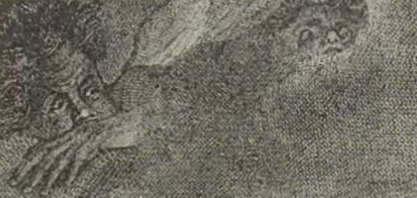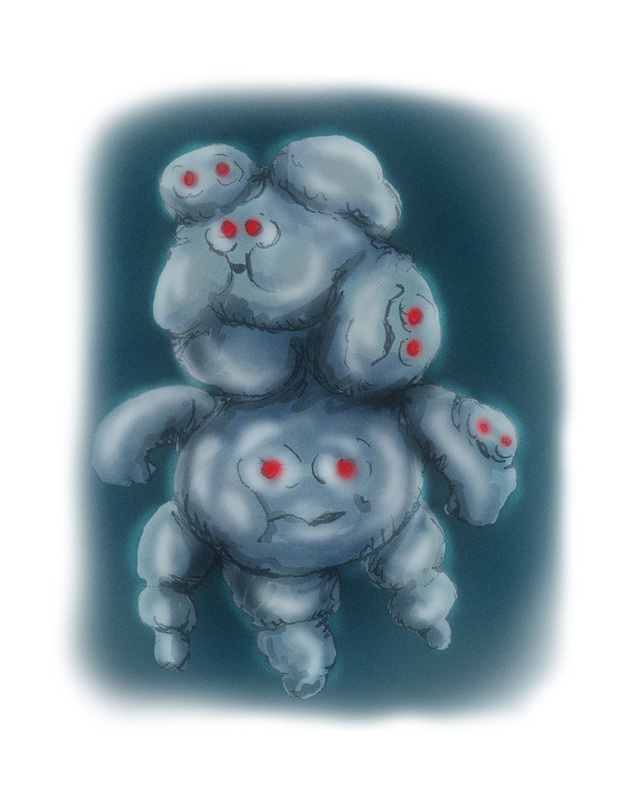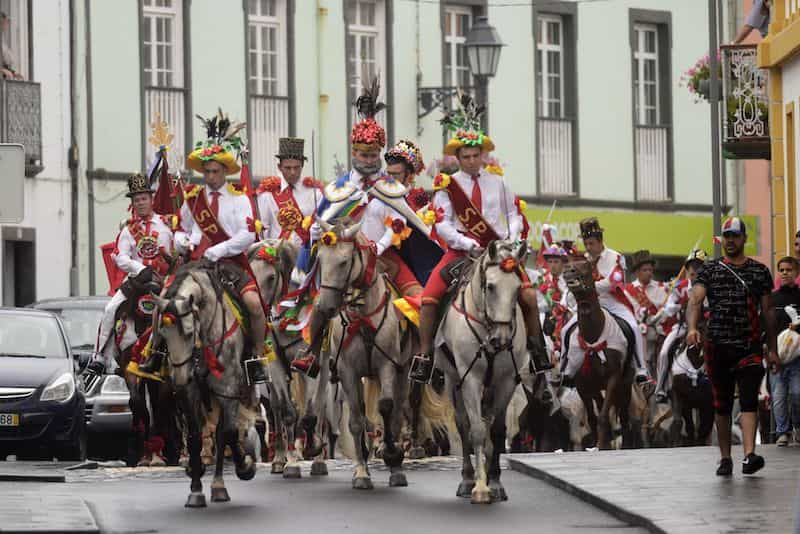Comparing Portuguese and Malay folklores (part 7)
(Continued from part 6)
- the Portuguese Tatro azeiteiro ("Olive-oil-oily Tatro", the latter word being of unknown origin/meaning) is a ghost who is the personification of fog, considered the provoker of it, as the ghost of a murdered man can provoke sudden mist as the Malay Hantu Daguk;
- mythological creatures from both national mythologies include:
- the Portuguese Alicórnio can be portrayed as a man with only one eye in the middle of the forehead, or a man with one horn in is head, or a sort of flying unicorn, as the Chinese-origin Qilin can appear in Malaysian folklore as a chimera, unicorn (Abath in Malaysia) or some weird hybrid sort of deer horned dragon,
- Caquesseitão (pronounced "Cah-ke-ssey-tah'aon, the "tah" and a"on" being said very fast into as much as possible one syllable) is a supposed real Sumatran animal similar to a black duck with thorns on its back, bat wings, cobra neck, a nail like a roosters spike on the forehead and a green and black very long tail only described by Portugal's "Marco Polo", Fernão Mendes Pinto, as Malaysian folklore inspired Argentinian writer (of Portuguese descent) Jorge Luis Borges to create the fictional non-Malay (Indian) Á Bao A Qu (meaning "big brother") mythical beast that chase those who climb a Rajputani tower,
- the Portuguese Cavalum (from "Pig Latin" for Cavalo/Horse) is a demon in the form of a horse with bat wings that challenged God and so was punished with being cast into Madeiran vulcanic tubes known as Furnas ("Hoven cavities") do Cavalum (where from time to time his supposed neighing is heard on stormy nights), a dark demon controled and burried under water and lake but that may come back to wreak havoc like the Seri Kemboja ("Cambodia's Glow") of indigenous Malay legend,
- magical plants for both folklores include:
- the Portuguese Erva fadada is a legendary magic plant that has the power of making damsels that touch in it pregnant (it is mentioned in xácaras/story-ballads, medieval romance novels and folk tales, having matches in Spanish, French and Thuringian German folklores) similarly to how in Malaysian folk medicine the real Akar Serapat (Parameria polyneura) can be used to stimulate female fertility and pregnancies,
- in Portuguese folklore the Boliana (Red Valerian) is said to grow a feather in Saint John's Night (which the witches use to sign a deal with the devil) and can be used for all sort of white and dark magic, like the Kacip Fatimah (Malay name for the plant scientifically known as Labisia pumila) can be used for several medicinal uses and especially for provoking pregnancy labor,
- the intermediate periwinkle is called by the Portuguese Erva-da-inveja ("Envy-Herb") since it is considered an ingredient in potions against the evil eye, as the Euricles amboinensis/Amaryllidaceae (called Sepenoh by the Malays) is considered to be by Malays and thorny cactus can be hung in doors and windows of expectant women to ward of evil and po(/u)ntianaks,
- the Feto-real (Flowering fern) is said by the Portuguese to grow a red flower on St. John's Night just before midnight, which can grant those who pick up said flower's invisible seed with a cloth before it falls down to the ground (and, being invisible, it will be lost for good) and protected by a signo saimão (corruption of "Solomon's symbol", the Star of David) draw on the floor (to protect from the demons, witches and haunting ghosts who also wish to take hold of the seed), knowledge about anything one wishes, magical strength to defeat demons and a "charismatic magnetism" that attracts whoever one wants to meet by meet cutes and make the attracted person ease more to the requests of the detainer of the magical seed, similarly to the China-originating (like there are leftovers of Jewish community beliefs in the Feto-real flower seed tradition, like the sign of Solomon) Clerodendron bungei/Glory flower having many spiritual and magical properties doubtfully attributed to it by the Malaysian, and more closely to the flower called by the Malays Sundal Malam ("Lady of the night") and by the cristangs Porka de Anoite ("Whore of the Night") flower which blooms exactly on the stroke of midnight for only 5 minutes (if one is lucky to see it bloom, wish on it and wishes may come true);
- general legends and traditions from both cultures include:
- the Portuguese Aranganho (Galician and Portuguese folk work derived from aranha/"spider" due to being considered provoked by a supernatural small critter, and tangaranho derived from the Latin tangere/"to touch/play") is a sort of evil-eye-related weakness-causing disease (like most diseases in Portuguese folk mythology, caused by the Ar Mau/"Bad Air" or Mal do Aire/"Ill-being out from the aire" spirit) that can be cured by a method of folk medicine of tying a child's wrists, then taking them to a crossroad where after praying the bindings would be cut and the disease would be assumed to get out, which is not too unlike some practices of the Malay Bomoh folk medical doctors to deal with the Jembalang demon/evil spirit who usually brings diseases (especially the one that causes swellings and abdomen problems, the Hantu Cika or Hantu Kembung);
- the Portuguese Cavalhadas (something like "Horseing-around") are horse-riding stagings included in folk theatre simulating fights of Christians and Moors in the French-origin epics of Charlemagne and his Peers of France in old times (equivalents played with puppets are called Robertos theatres) or done on their own which lost favour in most of Portugal (aside Vildemoinhos and Teive on the Viseu area where the horseriding aspect became secondary to Mardis-Gras-style June-July parades accompanied by music, Penafiel where Moors vs Christian performances, horse-riding and other Corpus Christi performances mix together, and Ribeira Grande on the Azores islands where July horse riding theatrical performance aspect remains pure) and are more common in Brazil now, similar to the Malay Kuda Kepang but without real horses (and an equivalent of foreign-stories-influenced theatre with puppets is the Kelantan state wayang siam),
- the Damas Pé-de-Cabra ("Goat Foot Ladies") appear in Portugal both in literature that records the family traditions of the originally Basque Lopez de Haro family (that also resided in Portugal, including is 4th queen Dona Mecia) and in a folk local variant (collected by scholar and writer João Palma-Ferreira in the 1980s) in the town of Marialva which deal with unions between common men with uncommon women (due to their feet feature), but while the literary variant is more like the Chinese-origin Legend of the White Snake (a story of love between a supernatural creature come from nature and a man from civilisation which is unnatural and so is a love not meant to be), the mountain Hantu Gunung spirit which turns into a beautiful woman to atract men, or the legend of a princess turned into the Seri Gumum/Tasik Chini Dragon or Naaga (Cobra serpent) or of love between the female Seri Gumum/Tasik Chini Naaga/dragon and the already mentioned male Naaga/dragon called Seri Kemboja which is the origin myth (as the literary Haro family Dama Pé-de-Cabra legend, at least in Alexandre Herculano's 19th century version, includes a tragic love story before the main one, which is the origin myth of the Haro family, about her turning into a ghostly or sort of evil fada demon with her lover being also turned into a supernatural monster, the fairy cavalo pardalo/leopard-coloured horse or magic onagro/onager donkey, a demon/fairy horse comparable to the Cavalum), the second is of a a normal and less evil woman (Maria Alva, "White Maria") who happens to have a flaw that will fate her to be lost aside the memory kept in the place where the story happened, more like the story of the pride of Si Tanggang turning him into a stone statue that is still where he turned,
(To be continued)
Images mostly from http://bibliotecasmp.blogspot.com/2018/02/o-carnaval-e-o-imaginario-tradicional.html (Carnaval/Mardi Gras ones), http://www.monsterku.com/malaysian-ghosts.html (the contemporary illustrations of Malay supernatural creatures) and the Bestiário Tradicional Português ("Portuguese Traditional Bestiary") book by Nuno Matos Valente and illustrated by Natacha Costa Pereira (in slighly cropped and altered pictures)
Comparando folclores português e malaio
(Continuado da parte 6)
- o Tatro azeiteiro (esta última palavra sendo de origem/significado desconhecidos) é um fantasma que é a personificação do nevoeiro, considerado o provocador dele, cmo o fantasma de um homem assassinado pode provocar névoa repentina como o Hantu Daguk malaio;
- criaturas mitológicas de ambas as mitologias nacionais incluem:
- o Alicórnio português pode ser representado como um homem com um só olho no meio da testa, ou um homem com um corno na sua cabeça, ou um tipo de unicórnio voador, como o Qilin de origem-portuguesa podem aparecer no folclore malaio como uma quimera, unicórnio (Abath na Malásia) ou algum híbrido estranho de dragão com cornos de veado,
- Caquesseitão é um suposto animal samatrês real similar a um pato preto com espinhos nas costas, asas pretas, pescoço de cobra, uma unha como o esporão de um galo sobre a testa e uma cauda verde e preta muito comprida só descrito pelo "Marco Polo", Fernão Mendes Pinto, como o escritor Argentino (de ascendência portuguesa) Jorge Luis Borges inspirado no folclóre malasiático para criar a a fera mítica não-malaia (indiana) fictícia Á Bao A Qu (significando "Grande irmão") que persegue aqueles que escalam uma torre rajapute,
- o Cavalum (do "Latim macarrónico" para Cavalo) é um demónio na forma de um cavalo com asas de morcejo que desafiava Deus e assim foi castigado sendo lançado para tubos vulcânicos madeirenses conhecidos como Furnas do Cavalum (onde de tempos a tempos o seu suposto relinchar é ouvido em noites tempestuosas), um demónio das trevas controlado e enterrado sob água e terra que poderá voltar para causar danos como o Seri Kemboja ("Brilho do Camboja") da lenda malaia indígena,
- plantas mágicas para ambos os folclores incluem:
- a Erva fadada portuguesa é uma planta lendária que tem o poder de fazer donzelas que a toquem engravidarem (é mencionada em xácaras/baladas-historiadas, romances românticos medievais e contos populares, tendo paralelos em folclore espanhol, francês e alemão turíngio) semelhante a como na medicina popular malaia a Akar Serapat (Parameria polyneura) real pode ser usada para stimular fertilidade feminina e gravidezes,
- no folclore português a Boliana (Valeriana Vermelha) diz-se que lhe cresce uma pena na Noite de São João (a qual as bruxas usam para assinar um pacto com o diabo) e pode ser usada para toda a sorte de magia branca e negra, como a Kacip Fatimah (nome malaio para a planta cientificamente conhecida como Labisia pumila) pode serusada para vários usos medicinais e especialmente para provocar trabalho de parto,
- a pervinca/o mirta/os caramujos de tamanhos intermédios é chamada pelos Portugueses Erva-da-inveja visto que é considerada um ingrediente em poções contra o mau olhado, como a Euricles amboinensis/Amaryllidaceae (chamada Sepenoh pelos Malaios) é considerada pelos Malaios como sendo isso e como os cactos espinhosos podem ser pendurados em portas e janelas de mulheres de esperanças para guardar do mal e de po(/u)ntianaks,
- o Feto-real é dito pelos Portugueses como crescendo uma flor vermelha na Noite de S. João mesmo antes da meia-noite, a qual pode conceder àqueles que apanham a semente invisível de dita flor com um pano anttes desta cair ao chão (e, sendo invisível, será perdida de vez) e protegido por um signo saimão (corrupção de "símbolo de Salomão", a Estrela de David) desenhado no chão (para proteger de demónios, bruxas e assombrações que também desejam tomar mão da semente), conhecimento sobre qualquer coisa que desejas, força mágica para derrotar demónios e um "magnetismo carismático" que atrai quem quer que queiras conhecer por encontros casuais e fazer a pessoa atraída abrir-se mais aos pedidos do detentor da semente mágica, similarmente à Clerodendron bungei/Hortênsia japonesa originária-na-China (como os restos de crenças da comunidade judaica na tradição da semente da flor do Feto-real, como o signo de Salomão) tendo muitas propriedades espirituais e mágicas de forma duvidosa atribuídas a ela pelos Malasiáticos, e mais de perto da flor chamada pelos Malaios Sundal Malam ("Senhora da Noite") e pelos cristangs flor Porka de Anoite ("Porca/P*ta da Noite") a qual floresce exactamente ao bater da mei-noite só por 5 minutos (se uma pessoa tiver sorte de a ver florescer, desejar sobre ela e os desejos podem tornar-se reais);
- lendas gerais e tradições de ambas as culturas incluem:
- o Aranganho (palavra popular galega e portuguesa derivada de aranha devido a ser considerada provocada por um bicinho sobrenatural, e tangaranho derivado do Latim tangere/"tocar [coisa/instrumento]") português é uma doença de-tipo-de-fraqueza provocada-pelo-mau-olhado (como a maioriadas doenças na mitologia popular portuguesa, causada pelo Ar Mau ou Mal do Aire/Ar/Epírito) que pode ser curada por um método de medicina popular de atar os pulsos de uma criança, e então levá-las a uma encruzilhada onde depois de rezarem as vendas seriam cortadas a doença seria assumida como tendo saído, o que não é demasiado desimilar dalgumas prácticas dos médicos populares Bomoh malaios para lidar com o demónio/espírito maléfico Jembalang que usualmente trazem doenças (especialmene as que causam inchaços e problemas do abdómen , o Hantu Cika ou Hantu Kembung);
- as Cavalhadas portuguesas são encenações de montaria incluindas em teatro popular simulando lutas de Cristãos e Mouros nas epopeias de-origem-francesa de Carlos Magnos e seus Pares de França (equivalentes interpretados com marionetas são chamadas teatros de Robertos) ou feitos sozinhos que perderam popularidade na maioria de Portugal (fora Vildemoinhos e Teive na área de Viseu onde os aspectos de montaria tornaram-se secundários a marchas ao-estilo-de-Carnaval de Junho-Julho acompanhadas por música, Penafiel onde interpretações Mouros versus Cristãos, montaria e outras interpretações de Corpo de Deus se misturam e Ribeira Grande na Ilhas dos Açores onde o aspecto de interpretações teatrais a cavalo em Julho permanece puro) e são mais comuns no Brasil agora, similarmente o Kuda Kepang malaio mas sem cavalos reais (e um equivalente de teatro influenciado-por-estórias-estrangeiras com marioneta é o wayang siam do estado de Kelantan),
- as Damas Pé-de-Cabra aparecem em Portugal quer em literatura que regista as tradições familiares da família Lopez/Lopes de Haro originalmente basca (que também residia em Portugal, incluindo a sua quarta rainha Dona Mécia) e em variante local folclórica (coligida pelo erudito e escritor João Palma-Ferreira nos anos de 1980) na vila de Marialva as quais lidam com uniões entre homens comuns com mulheres incomons (devido aos seus traços dos pés), mas enquanto a variante literária é mais como a Lenda da Cobra Branca de-origem-chinesa (uma estória de amor entre uma criatura sobrenatural vinda da natureza e um homem da civilização que é não-natural e assim é um amor que não está destinado a concretizar-se), o espírito das montanhas Hantu Gunung que se transforma numa linda mulher para atrair homens, ou a lenda da princesa transformada no Dragão ou Naaga (Cobra) Seri Gumum/Tasik Chini ou o amor entre uma/um Nagaa/dragão Seri Gumum/Tasik Chini e a/o já mencionada/o Naaga/dragão chamada Seri Kemboja a qual é um mito original (como a lenda literária da Dama Pé-de-Cabra da família Haro, pelo menos na versão do século XIX de Alexandre Herculan, inclui uma estória de amor trágica antes da principal, que é o mito daorigem da família Haro, sobre ela transformar-se num demónio fantasmagótico ou tipo de fada maléfica com o seu amante a ser também tornado num monstro sobrenatural, um cavalo pardalo/"cavalo-cor-de-leopardo" ou asno-bravo onagro mágico feérico, um cavalo demónio/fada comparável ao Cavalum), a segunda lenda é de uma mulhr normal e menos maléfica (Maria Alva, "Branca") que lhe passa ter uma falha que a fadará a ser perdida fora a memória mantida do lugar ond a história decorre, mais como a história do orgulho de Si Tanggang transformá-lo numa estátua de pedra que ainda está onde foi transformado,
(A continuar)
Imagens principalmente de http://bibliotecasmp.blogspot.com/2018/02/o-carnaval-e-o-imaginario-tradicional.html (as do Carnaval), http://www.monsterku.com/malaysian-ghosts.html (ilustrações contemporâneas de criaturas sobrenaturais malaias) e do livro Bestiário Tradicional Português de Nuno Matos Valente e ilustrada por Natacha Costa Pereira (em imagens ligeiramente cortadas e alteradas)

 (modern illustration of the Hantu Daguk)
(modern illustration of the Hantu Daguk)








Comentários
Enviar um comentário